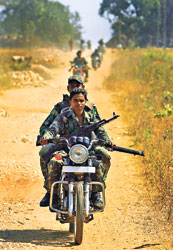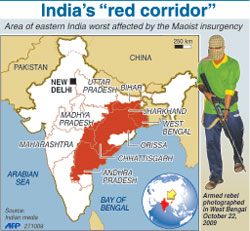The longstanding tussle between the Indian security establishment and the Left extremist Communist Party of India (Maoist) is all set to enter a crucial and perhaps decisive phase in the next few months. This is the unmistakable message one gets from the developments over the past two months in New Delhi and different parts of central and eastern India. '
Central to these developments and the projections that have emanated from them is the new strategy (and initiatives related to it) advanced by the Union Home Ministry and the Maoists' own plans to impart a concerted thrust to their activities and spread to new areas.
Historically, the battle with the Maoists has raged since 1967 when the first Maoist rebellion erupted. The battle intensified over the last five years following the formation of the CPI (Maoist), in 2004, through the merger of two prominent naxalite groups, the Peoples War Group (PWG) and the Maoist Communist Centre (MCC).
Over the past two months the government has pressed new battalions of security forces into anti-Maoist combat operations and many of them have been deployed. There have also been discussions about involving the Army and even the Air Force in the operations.
 |
| Indian Special Police Officers patrolling the Maoist-infested Dantewada district in Chhattisgarh as the Indian government is preparing for a massive military operation in the area. AFP |
The CPI (Maoist), on its part, has intensified its attacks in different parts of the country. They include Jharkhand, Chhattisgarh and Orissa, which are the organisation's strongholds, the Gadchiroli region in Maharashtra, where it is apparently recapturing lost space, and parts of West Bengal, where it has made forays in the past two years.
Officials in the Home Ministry coordinating the new combat initiative say the government has ventured into this with some spectacular successes. The reference, obviously, is to the arrest of Kobad Ghandy and Amitabh Bagchi, senior politburo members of the CPI (Maoist). According to security agencies, Ghandy was arrested in New Delhi on September 21 and Bagchi in Ranchi, the capital of Jharkhand, on August 24.
The Maoists responded to these "captures" through a series of attacks across central and eastern India. Perhaps the most daring among these was the killing of 18 members of a police party in an ambush in Gadchiroli district on October 8, five days before polling in the State Assembly elections. The brutal beheading of abducted Jharkhand Police Inspector Francis Induwar two days earlier also captured widespread attention.
While these incidents evoked strong condemnation from several quarters, many senior Maoist activists who interacted with Frontline said the purpose of the attacks was to prove that the strike power of the Maoists remained undiminished despite the capture of some leaders. "All these forays have asserted that the party is moving forward in fulfilling the organisational tasks laid out by the politburo in its historic circular of June 12," said CPI (Maoist) politburo member Koteswar Rao alias Kishenji to Frontline over telephone.
The June 12 intra-party circular titled "Post Election Situation - Our Tasks" etched out a number of immediate and long-term tasks for the cadre. Kishenji's contention was that the Gadchiroli attack and the Ranchi killing showed that the party was on course to fulfilling these tasks.
According to Union Home Secretary Gopal Krishna Pillai, the arrests of Ghandy and Bagchi signify remarkable improvement in terms of intelligence gathering vis-à-vis Maoist operations. "The series of inter-State meetings the Union Home Ministry organised over the past two years at different levels of political and administrative authority resulted in better coordination among the security forces in different States and that contributed to improved intelligence gathering," Pillai told Frontline.
The new Home Ministry initiative is also broadly based on the confabulations that took place over the past two years under the auspices of the Ministry and involved Chief Ministers, State Home Ministers and senior officials in government and the police departments.
Detailed study
Union Home Ministry officials pointed out that as part of the new initiative a detailed study of the Maoist-affected areas was done and the most sensitive and difficult areas were mapped. The study identified 11 areas as most sensitive, spread over 40 districts.
According to the Home Ministry's own figures, overall Maoist influence has spread from 56 districts in 2001 to 223 in 2009. It rated about 70 of these as worst-affected, and the 40 identified districts in the 11 mapped areas qualify as the worst-affected among these. An additional 70 battalions of security forces have been earmarked for operations in these 11 areas.
The 40-odd battalions already deployed in Maoist-affected areas would not be withdrawn even after the induction of the additional forces. According to Ajit Sahni, one of the country's foremost security analysts and executive director of the Delhi-based Institute of Conflict Management, all well-laid-out plans can come a cropper if intense efforts are not made to enhance and improve general policing and remove political intervention in, and political corruption of, the security establishment.
According to experts, the shortage in terms of police personnel in the country is to the tune of several lakhs and that, too, as per the old proportion of having an inspector and six constables in a police station. As per modern police manuals, a police station requires as many as 20 policemen in a vastly populated country like India.
Sahni and many other security specialists also pointed out that the debate on involving the Army and the Air Force in the operations was an unwanted distraction. Talking to Frontline, Sahni indicated that such discussions are ludicrous and are symptomatic of the deep malaises that afflict the system.
The debate was taken to such levels, and that too by some senior Defence officers themselves, that Prime Minister Manmohan Singh himself was forced to issue a clarification on the issue. It was the IAF vice-chief, Air Marshal P.K. Barbora, who maintained that the force had asked the government to be given the authority to open fire in self-defence if fired upon by the Maoists during operations. Manmohan Singh made it clear that the government was not considering any such plan. Notwithstanding the clarification, the confusion created by the debate remained, including in some segments of the media.
Maoists undeterred
As for the Maoists, their leadership asserted that the government initiatives would not detract them from going ahead with their plans as laid out in the June 12 circular. The 14-page note, apparently drafted by Kobad Ghandy, analyses the 2009 Lok Sabha elections in detail and terms it as a sham verdict meant to legitimise neoliberal reforms and state oppression. In the background of this analysis, the document stated that more and more people belonging to the poor and oppressed sections of society would get attracted to Maoist activities and that this needed to be strengthened.
Talking to Frontline over telephone about the party's growth plans, CPI (Maoist) politburo member Koteswar Rao said the original aim of the party at the time of the 2004 merger was to fill the ideological vacuum in terms of Leftist, people-oriented politics. "We are steadily reaching there, especially because all mainstream parties have given up on core issues of the people," he said.
- Courtesy Frontline, India |


